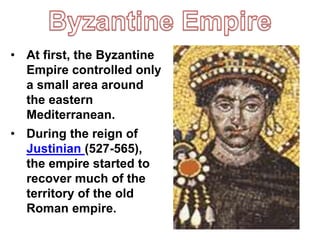Roman empire lesson 8 byzantine empire
- 1. By the late 400s, life in Rome became very difficult. RomeŌĆÖs population decreased and schools began to close. Taxes as well as prices for goods soared, leaving the Roman people very poor. By the late 400s, Rome and the entire Roman Empirempire slowly collapsed. If you were living in Rome during the 400s, what would you do to help fix the problems that Rome faced? Write 3-5 sentences as a response.
- 2. I can analyze the legacy of the Byzantine Empire and its rulers. 7.2 Summarize the consequences of the fall of the Roman Empire including the continuation of the Eastern Roman Empire as the Byzantine Empire, Justinian and the significance of Constantinople.
- 3. In 284 AD Diocletian became Roman emperor. He decided that the huge Roman empire could only be ruled effectively by splitting it into two parts. How would this division impact the Roman Empire?
- 4. ŌĆó In 330 AD Constantine rebuilt the old Greek port of Byzantium, at the entrance to the Black Sea. ŌĆó He renamed the city Constantinople and made the city the capital of the Eastern Roman Empire.
- 5. How does ConstantinopleŌĆÖs location on the map aid the city in terms of trade and power?
- 6. ŌĆó By 395 AD, the Roman Empire was formally divided into two empires. The Eastern Roman Empire and the Western Roman Empire ŌĆó With the invasion of Germanic forces from the north, the Western Roman Empire was conquered and divided.
- 7. The Byzantine Empire was wealthy and produced goods such as gold, silk, grain, olives, and wine. They traded these for spices, ivory and precious stones from countries as far away as China and India along the Silk Road trade routes.
- 8. ŌĆó At first, the Byzantine Empire controlled only a small area around the eastern Mediterranean. ŌĆó During the reign of Justinian (527-565), the empire started to recover much of the territory of the old Roman empire.
- 9. The Byzantine Empire Under Justinian This map depicts the Empire at the death of Justinian I, who had reigned from 527 to 565 as sole Emperor, sometimes in concert, and sometimes in conflict, with his powerful wife Theodora.
- 10. - They built this beautiful church named Hagia Sophia which still stands to this day. - Justinian ruled with complete authority with the help of Theodora. - Together they created a massive Christian empire.
- 11. Justinian organized all the laws of ancient Rome. ŌĆó Laws were fairer to women allowing them to own property. ŌĆó Children were allowed to choose their own marriage partners. ŌĆó Punishments were detailed and fit the crime. ŌĆó His work inspired the modern concept of justiceŌĆ”hence his name.
- 12. ŌĆó The Byzantine Empire drew to a close in 1453 when forces from the Muslim Ottoman Empire to the south surrounded and conquered Constantinople. ŌĆó The ancient Christian city was renamed Istanbul and became the capital of the Ottoman Empire.
- 13. 10 minutes End The Byzantine Empire
- 14. Download more FREE World History & Geography lessons onŌĆ” www.alanbaumer.com













